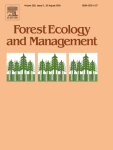View Item
- xmlui.general.dspace_homeCentros Regionales y EEAsCentro Regional Patagonia NorteEEA BarilocheArtículos científicosxmlui.ArtifactBrowser.ItemViewer.trail
- DSpace Home
- Centros Regionales y EEAs
- Centro Regional Patagonia Norte
- EEA Bariloche
- Artículos científicos
- View Item
What is hot in tree rings? The wood density of surviving Douglas-firs to the 2003 drought and heat wave
Abstract
In a global warming scenario, drought and heat waves like the one that occurred in 2003 in Europe are expected to become more intense and frequent. This extreme climate event strongly affected the hydraulic balance in many forest tree species including Douglas-fir, with symptoms ranging from partial crown necrosis to death. We studied a French Douglas-fir provenance trial, strongly affected by the 2003 drought and heat wave. Using wood X-ray microdensity
[ver mas...]
In a global warming scenario, drought and heat waves like the one that occurred in 2003 in Europe are expected to become more intense and frequent. This extreme climate event strongly affected the hydraulic balance in many forest tree species including Douglas-fir, with symptoms ranging from partial crown necrosis to death. We studied a French Douglas-fir provenance trial, strongly affected by the 2003 drought and heat wave. Using wood X-ray microdensity profiles as a record of cambium response to
environmental variations, we compared mean stem density and growth between dead and alive neighbouring trees and several microdensity characters measured over 17 growth rings previous to 2003.
Special attention has been given to the sampling layout in order to minimize the micro-environmental effects. At tree level, surviving trees have a significantly highermean stem density. At tree ring level, they have a significantly higher mean ring density, maximum ring density, latewood density and, to a lesser extent, latewood proportion. No significant difference was found for diameter growth. These results could have direct implications in the way to study and predict possible acclimation and adaptation of forest trees to climate change process. Wood could be used for the selection of genotypes with a desirable plasticity and resistance to drought induced-cavitation
[Cerrar]

Author
Martinez Meier, Alejandro;
Sanchez, Leopoldo;
Pastorino, Mario Juan;
Gallo, Leonardo Ariel;
Rozenberg, Philippe;
Fuente
Forest Ecology and Management 256 (4) : 837-848 (Agosto 2008)
Date
2008-08
Editorial
Elsevier
ISSN
0378-1127
Formato
pdf
Tipo de documento
artículo
Palabras Claves
Derechos de acceso
Restringido
 Excepto donde se diga explicitamente, este item se publica bajo la siguiente descripción: Creative Commons Attribution-NonCommercial-ShareAlike 2.5 Unported (CC BY-NC-SA 2.5)
Excepto donde se diga explicitamente, este item se publica bajo la siguiente descripción: Creative Commons Attribution-NonCommercial-ShareAlike 2.5 Unported (CC BY-NC-SA 2.5)

